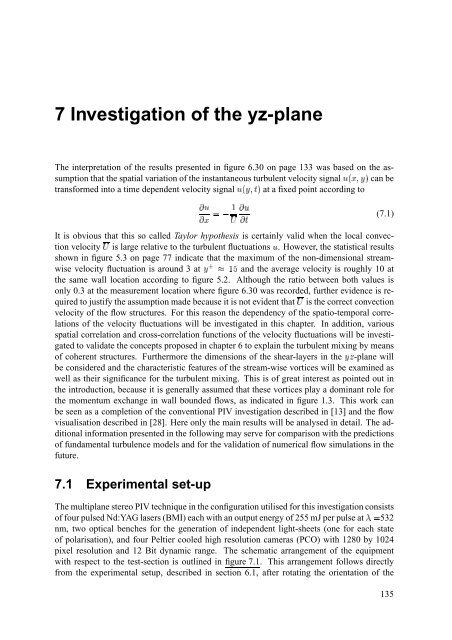The significance of coherent flow structures for the turbulent mixing ...
The significance of coherent flow structures for the turbulent mixing ...
The significance of coherent flow structures for the turbulent mixing ...
You also want an ePaper? Increase the reach of your titles
YUMPU automatically turns print PDFs into web optimized ePapers that Google loves.
'§<br />
'Î<br />
ª ¿<br />
¦<br />
'§<br />
')(<br />
7 Investigation <strong>of</strong> <strong>the</strong> yz-plane<br />
<strong>The</strong> interpretation <strong>of</strong> <strong>the</strong> results presented in figure 6.30 on page 133 was based on <strong>the</strong> assumption<br />
that <strong>the</strong> spatial variation <strong>of</strong> <strong>the</strong> instantaneous <strong>turbulent</strong> velocity signal § ¹ Î Á ¼ can be<br />
trans<strong>for</strong>med into a time dependent velocity signal § ¹| Á:(¼ at a fixed point according to<br />
(7.1)<br />
It is obvious that this so called Taylor hypo<strong>the</strong>sis is certainly valid when <strong>the</strong> local convection<br />
¦ velocity is large relative to <strong>the</strong> <strong>turbulent</strong> § fluctuations . However, <strong>the</strong> statistical results<br />
shown in figure 5.3 on page 77 indicate that <strong>the</strong> maximum <strong>of</strong> <strong>the</strong> non-dimensional streamwise<br />
velocity fluctuation is around 3 at ® Ê ª Ç<br />
and <strong>the</strong> average velocity is roughly 10 at<br />
<strong>the</strong> same wall location according to figure 5.2. Although <strong>the</strong> ratio between both values is<br />
only 0.3 at <strong>the</strong> measurement location where figure 6.30 was recorded, fur<strong>the</strong>r evidence is required<br />
to justify <strong>the</strong> assumption made because it is not evident ¦ that is <strong>the</strong> correct convection<br />
velocity <strong>of</strong> <strong>the</strong> <strong>flow</strong> <strong>structures</strong>. For this reason <strong>the</strong> dependency <strong>of</strong> <strong>the</strong> spatio-temporal correlations<br />
<strong>of</strong> <strong>the</strong> velocity fluctuations will be investigated in this chapter. In addition, various<br />
spatial correlation and cross-correlation functions <strong>of</strong> <strong>the</strong> velocity fluctuations will be investigated<br />
to validate <strong>the</strong> concepts proposed in chapter 6 to explain <strong>the</strong> <strong>turbulent</strong> <strong>mixing</strong> by means<br />
<strong>of</strong> <strong>coherent</strong> <strong>structures</strong>. Fur<strong>the</strong>rmore <strong>the</strong> dimensions <strong>of</strong> <strong>the</strong> shear-layers in <strong>the</strong> Ï -plane will<br />
be considered and <strong>the</strong> characteristic features <strong>of</strong> <strong>the</strong> stream-wise vortices will be examined as<br />
well as <strong>the</strong>ir <strong>significance</strong> <strong>for</strong> <strong>the</strong> <strong>turbulent</strong> <strong>mixing</strong>. This is <strong>of</strong> great interest as pointed out in<br />
<strong>the</strong> introduction, because it is generally assumed that <strong>the</strong>se vortices play a dominant role <strong>for</strong><br />
<strong>the</strong> momentum exchange in wall bounded <strong>flow</strong>s, as indicated in figure 1.3. This work can<br />
be seen as a completion <strong>of</strong> <strong>the</strong> conventional PIV investigation described in [13] and <strong>the</strong> <strong>flow</strong><br />
visualisation described in [28]. Here only <strong>the</strong> main results will be analysed in detail. <strong>The</strong> additional<br />
in<strong>for</strong>mation presented in <strong>the</strong> following may serve <strong>for</strong> comparison with <strong>the</strong> predictions<br />
<strong>of</strong> fundamental turbulence models and <strong>for</strong> <strong>the</strong> validation <strong>of</strong> numerical <strong>flow</strong> simulations in <strong>the</strong><br />
future.<br />
7.1 Experimental set-up<br />
<strong>The</strong> multiplane stereo PIV technique in <strong>the</strong> configuration utilised <strong>for</strong> this investigation consists<br />
<strong>of</strong> four pulsed Nd:YAG lasers (BMI) each with an output energy <strong>of</strong> 255 mJ per pulse at ¢ ¿<br />
532<br />
nm, two optical benches <strong>for</strong> <strong>the</strong> generation <strong>of</strong> independent light-sheets (one <strong>for</strong> each state<br />
<strong>of</strong> polarisation), and four Peltier cooled high resolution cameras (PCO) with 1280 by 1024<br />
pixel resolution and 12 Bit dynamic range. <strong>The</strong> schematic arrangement <strong>of</strong> <strong>the</strong> equipment<br />
with respect to <strong>the</strong> test-section is outlined in figure 7.1. This arrangement follows directly<br />
from <strong>the</strong> experimental setup, described in section 6.1, after rotating <strong>the</strong> orientation <strong>of</strong> <strong>the</strong><br />
135
















